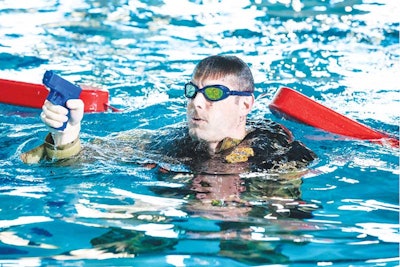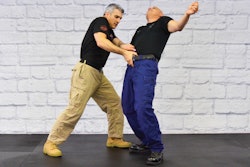 In the CBP’s Tactical Water Survival Training Program, Marine Interdiction Agents are taught to survive and even fight when they end up in the water.
In the CBP’s Tactical Water Survival Training Program, Marine Interdiction Agents are taught to survive and even fight when they end up in the water.
As a uniformed component of U.S. Customs and Border Protection (CBP), with 1,800 federal law enforcement officers, agents, and mission support personnel, Air and Marine Operations (AMO) conducts missions throughout the United States, including the Caribbean territories of Puerto Rico and the and U.S. Virgin Islands.
In addition to interdiction operations involving the detection, prevention, and apprehension of terrorists, illegal weapons, contraband, and persons illegally entering or attacking the United States, AMO’s Marine Interdiction Agents are involved in Department of Homeland Security missions.
During Super Bowl LIV in Miami, Marine Interdiction Agents were tasked with patrolling a security zone around Biscayne Bay in connection with Super Bowl-related events. Marine Interdiction Agents patrolled the Potomac River in Washington, DC, during the annual State of the Union address. Also, these agents frequently respond to natural disaster relief and recovery events such as hurricanes.
AMO has nearly 300 Marine Interdiction Agents operating in a water environment daily, interdicting smugglers and aliens attempting to enter the U.S. illegally. Which means AMO training is very different from conventional law enforcement training.
A Training Challenge
At its inception, the Marine Interdiction Agent training program focused mainly on navigation, vessel-to-vessel interception, pursuit, disabling strategies, and boarding tactics and techniques. These skills are the necessary fundamentals required to make a successful interdiction. However, the focus of these tactics presumed that agents would remain on the vessels.
The questions that needed to be asked and answered were: What happens when an agent ends up in the water? What happens when the subjects end up in the water? How can agents help a subject in distress in the water? What happens when the subjects are combative in the water?
AMO’s Marine Interdiction Agents spend up to 800 hours on the water annually, so the probability of ending up in the water is high. However, many were not properly prepared for it.
“A lot of our Marine Interdiction Agents were getting little to no training on how to handle situations if they were to find themselves in the water. It doesn’t matter how they got there; they are now in the water with all of their gear on, and they [didn’t] have any formal training to figure out how to get out of it,” says Supervisory Marine Interdiction Agent Ben Westrope.
“We give the agents tools to do just about everything else. From the day they are hired, AMO teaches the agents how to drive boats, how to shoot multiple firearms accurately, and how to disable a non-compliant vessel, but we [didn’t] teach them how to save their own lives if they were to fall in the water,” Westrope explains.
In 2015, AMO’s National Marine Training Center began to provide basic instruction to Marine Interdiction Agents on the use of flotation devices, life rafts, and swimmer rescue. At the end of that first year, instructors determined: Roughly two-thirds of agents were rated as “weak” swimmers or “non-swimmers,” and student/agent feedback indicated that, by the end of the instruction, they worried more about an unplanned entry into an ocean or lake because they had “learned enough to know they did not know enough.”
Many of the Marine Interdiction Agents had experience in prior career fields that required some water survival training. For those who did not, few had sought any formal water survival training before working in a new environment. Many first-year students said water survival training was long overdue and they now felt better prepared.
Changing the Training
In response, AMO developed the Tactical Water Survival Training Program at the National Marine Training Center in St. Augustine, FL, in 2019.
AMO’s Tactical Water Survival Training comprises 16 hours of instruction. The class prepares Marine Interdiction Agents for the circumstances if they “go in the water” due to incident or accident, including providing mental and physical tools to overcome challenges faced in the water while wearing law enforcement uniforms and gear.
This course emphasizes four major points: swimming strokes and techniques, treading water, red man drills, and scenarios.
Swimming Strokes and Techniques: This block of instruction begins with discussion of each stroke, the differences, and why they are critical to Marine Interdiction Agents.
Two instructors demonstrate strokes. Each agent then enters the water and performs the stroke just observed. Once they reach the other end of the pool 25 yards away, the instructors in the water—every agent has their own instructor—give feedback on technique and what the agent can do to become more efficient. Agents learn the freestyle stroke, sidestroke, breaststroke, elementary backstroke, underwater stroke, breaststroke with gun out, and backstroke with gun out.
Treading Water: This is probably the most physically demanding eight minutes of the course, and it is one of the most critical blocks of the training. Officers and agents must be able to think and respond quickly if they end up in the water.
The agents enter the water wearing shoes/boots, cargo pants, a gun belt with a blue gun, 25 pounds of dive weights, a t-shirt, and body armor. Agents are expected to tread water for three minutes.
At the three-minute mark, they start drown proofing. In this technique, agents get rid of all unnecessary gear, but they must keep their guns. They start by dropping the gun belt. Next, they take off their shoes and keep them nearby, as shoes are neutrally buoyant. Then they take off pants, tie the pant legs into a knot, and splash water into the pants, which adds air. This turns their pants into a life jacket, helping them to bring their heart rate down and calm their nerves. Panicking prevents agents from being able to think clearly and make the best, life-saving decisions, for themselves and potential victims. Once the entire class can safely float using their gear, they have successfully completed this portion of the training.
Red Man Drills: Red Man drills are simulations where an instructor wearing Red Man protective gear acts as a combatant. The agents practice hand-to-hand combat using tactics taught by the instructors.
The drills are first conducted poolside on a mat for safety purposes. Agents learn a variety of drills. The student gets several repetitions entering the water hand-to-hand with a subject. This is where the class becomes more dynamic because there are multiple people entering the water at the same time.
Once in the water, the agents work on defensive tactics to disengage from the subject. They also work on tactics such as engaging a threat outside the water and learning how to enter the water in a manner that gives them a tactical advantage. Finally, the course teaches agents how to engage and disengage with a threat while in the water while coming to the aid of another officer or agent.
 During scenario training, agents are taught how to combine all of the skills they learn in the program and apply them in practical exercises.
During scenario training, agents are taught how to combine all of the skills they learn in the program and apply them in practical exercises.
Scenarios: Scenario training combines all of the lessons from the two-day class. An instructor does a scenario pre-brief. Scenarios have multiple role players and multiple safety instructors. After the scenario is complete, each agent is given an opportunity to explain and justify their actions and explain what they would do differently. Use-of-force questions are asked and answered, and possible alternate law enforcement conclusions to each scenario are discussed. Scenario training allows agents to commit the information to muscle memory, so that when they encounter these situations in real life, they are able to respond, quickly, appropriately and within agency policy.
State and Local Applications
While the program is currently offered only to AMO’s Marine Interdiction Agents, Agent Westrope says similar training is applicable to any law enforcement officer or agent who works in a water environment.
“We are teaching them how to swim with all their gear on, and how you can use your own gear to help you float,” Westrope says. “We see state and local law enforcement engaging with the public on the water all the time. Maybe it is the Fourth of July, or Memorial Day, days when there are many people on the water. Officers are looking at vessels and talking to people, and they need to be trained, should something happen.”
AMO’s instructors at the National Marine Training Center have perfected best practices for this type of in-water training. The application of Tactical Water Survival Training can significantly enhance officer safety in coastal, river, and lake environments.
Christiana Coleman is the communications manager for Air and Marine Operations. To learn more about AMO and its mission, visit https://www.cbp.gov/border-security/air-sea.











